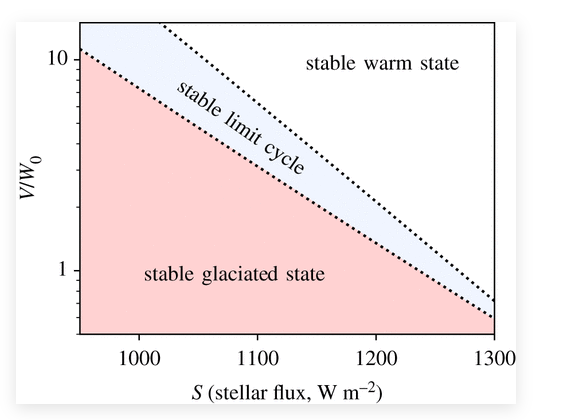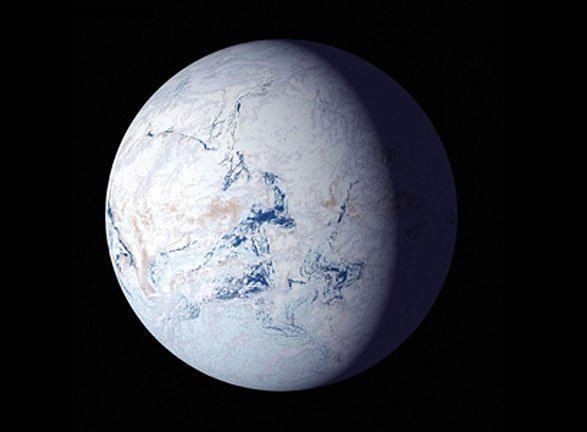Hundreds of millions of years ago, Earth went through two episodes of severe glaciation. These two episodes—the Sturtian and the Marinoan glaciations—occured during the Earth’s Cryogenian Period. The Cryogenian lasted from about 720 million to 635 million years ago.
The phenomenon is called “Snowball Earth” and both instances of it happened in pretty quick succession. And while a planet encased in ice and snow sounds devastating, these episodes may have paved the way for the development of complex life.
The question is, what caused the Earth to freeze over like that?
Scientists have been trying to understand the cause of these Snowball Earth episodes, but haven’t come to any clear conclusion. The thinking goes that there must have been some threshold in the climate that was breached, as if a toggle switch was flipped, tipping the Earth into global glaciation. Some have suggested that a drop in solar radiation or atmospheric CO2 could have done it.
But a new study says that while lowered solar radiation and atmospheric CO2 could have done it, the mechanism doesn’t involve a critical threshold being breached. It just has to drop quickly in a short period of time.
The new study is titled “Routes to global glaciation” and it’s published in the journal Proceedings of the Royal Society A. The lead author is Constantin W. Arnscheidt, a graduate student in MIT’s Department of Earth, Atmospheric and Planetary Sciences (EAPS).
There’s some controversy around this topic. Not everyone agrees that there were two Snowball Earth episodes. Some of the evidence, like sedimentary deposits with a likely glacial origin found in tropical paleolatitudes, is still the subject of debate. And some scientists say the idea of a globally glaciated Earth isn’t feasible, and wonder how the Earth could have ever recovered from it. Others say that the Earth never glaciated completely, and that a “Slushball Earth” is more likely, where the region around the equator doesn’t freeze solid.
But the authors of this paper have tackled the issue of how Snowball Earth could’ve happened.
The researchers behind this work point to what they call “rate-induced glaciation” as the cause of the global glaciations. In their scenario, a drop in incoming solar radiation plays a critical role. But unlike other scenarios, where the radiation drops below a particular threshold and causes glaciations, this research shows that it’s more about how quickly the radiation drops. If incoming sunlight decreases quickly enough, a temporary glaciation like Snowball Earth will take place.

A number of things could cause that acute drop in sunlight. Widespread volcanic eruptions or rapid, biologically induced cloud formations could do it. But once the glaciation got going, the Earth’s albedo would rise and reflect more solar radiation back into space, feeding the glaciation. If things go far enough, it results in a global glaciation.
There’s general agreement among scientists that incoming solar radiation, ice-albedo feedback, and atmospheric CO2 all have a role in Snowball Earth. But typically, the thinking is focused on solar radiation thresholds.
“There are lots of ideas for what caused these global glaciations, but they all really boil down to some implicit modification of solar radiation coming in,” lead author Arnscheidt said in a press release. “But generally it’s been studied in the context of crossing a threshold.”
But the pair of researchers behind this paper took a different tack. They’ve both studied other events in Earth’s deep past, like mass extinctions. In events like that, the speed or rate of change in climate factors is what led to the extinctions. For example, if the oceans warm too quickly, organisms don’t have time to adapt, and to find new niches. The authors wondered if a similar thing happened with Snowball Earth.
![This illustration from a separate study on extinctions shows the percentage of marine animals that went extinct during Earth's worst extinction at the end of the Permian era by latitude, from a model (black line) and from the fossil record (blue dots). A greater percentage of marine animals survived in the tropics than at the poles. The color of the water shows the temperature change, with red being most severe warming and yellow less warming. The researchers behind this new work have studied extinctions, and how rapid change can cause them, and wondered if something similar happened in the climate during the Snowball Earth global glaciations. [Includes fossil drawings by Ernst Haeckel/Wikimedia; Blue crab photo by Wendy Kaveney/Flickr; Atlantic cod photo by Hans-Petter Fjeld/Wikimedia; Chambered nautilus photo by John White/CalPhotos.]Justin Penn and Curtis Deutsch/University of Washington](https://www.universetoday.com/wp-content/uploads/2018/12/Penn_sumfig_final-1024x561.jpg)
“In the course of this exercise, we realized there was an immediate way to make a serious point by applying such ideas of rate-induced tipping, to Snowball Earth and habitability,” Rothman says.
In their paper, the authors write that “It is well understood that glaciation can be initiated on Earth-like planets when changes in radiative fluxes or in CO2 fluxes exceed a critical threshold. Here, we have demonstrated and explained an additional possibility: glaciation is initiated when changes in radiative fluxes exceed a critical rate.”
“… it teaches us that we should be wary of the speed at which we are modifying Earth’s climate, not just the magnitude of the change.”
CONSTANTIN W. ARNSCHEIDT, LEAD AUTHOR, GRAD STUDENT IN MIT’S DEPARTMENT OF EARTH, ATMOSPHERIC AND PLANETARY SCIENCES (EAPS).
Their work revolves around simulations, and two factors are key in those simulations: the radiative flux, or change in amount of sunlight reaching Earth, and the carbonate-silicate cycle. The carbonate-silicate cycle is also called the inorganic carbon cycle, and it describes how atmospheric carbon is sequestered back into rock, and how it’s released into the atmosphere again by volcanic activity. In geological time scales, the inorganic carbon cycle has a large effect on climate.
The researchers created a model that included both incoming and outgoing solar radiation, the Earth’s surface temperature, atmospheric CO2, and the inorganic carbon cycle. They tuned each of these parameters to see which scenarios resulted in a Snowball Earth.
Their primary finding was that global glaciation was a result of incoming solar radiation when that incoming radiation dropped too quickly. Their model is a necessary simplification of the Earth’s climate, so there’s uncertainty when it comes to determining exactly how quickly is too quickly. But as a general conclusion, the authors estimate that if the incoming solar radiation dropped 2% in about 10,000 years, the Earth would tip over into global glaciation.
“This is a consequence of the timescale contrast between radiative equilibration and equilibration of atmospheric CO2 by the carbonate–silicate cycle,” the authors write in their paper. “During a rate-induced glaciation, the warm stable climate state does not lose stability; this motivates our identification of the two dynamically different routes to glaciation.”
In the paper they outline two different routes to Snowball Earth. There must be a rapid increase in volcanic outgassing, and/or a rapid decrease in incoming solar radiation, which results in more ice coverage and a higher albedo.

“It’s reasonable to assume past glaciations were induced by geologically quick changes to solar radiation,” Arnscheidt says.
Exactly what could’ve caused this precipitous drop in incoming sunlight is still up for debate. Heightened volcanic activity is a potential cause, as are reflective clouds that might’ve been created by primitive algae. If this research is correct, both of those are candidate causes.
“Even though humanity will not trigger a snowball glaciation on our current climate trajectory, the existence of such a ‘rate-induced tipping point’ at the global scale may still remain a cause for concern,” Arnscheidt points out. “For example, it teaches us that we should be wary of the speed at which we are modifying Earth’s climate, not just the magnitude of the change. There could be other such rate-induced tipping points that might be triggered by anthropogenic warming. Identifying these and constraining their critical rates is a worthwhile goal for further research.”
This research can also tell us something about explanets and habitability.
“What this highlights is the notion that there’s so much more nuance in the concept of habitability.”
Constantin W. Arnscheidt, Lead Author, grad student in MIT’s Department of Earth, Atmospheric and Planetary Sciences (EAPS).
A key concept in explanet research is the habitable zone, a region that’s not too close and not too far from a star that allows liquid water to flow on the surface of a planet. This research shows that even a planet in a habitable zone could experience global glaciation if it experiences rapid enough changes. After all, Earth has experienced two episodes of Snowball Earth while it’s inside the Sun’s habitable zone.
“You could have a planet that stays well within the classical habitable zone, but if incoming sunlight changes too fast, you could get a Snowball Earth,” says lead author Arnscheidt. “What this highlights is the notion that there’s so much more nuance in the concept of habitability.”
More:
- Press Release: Study: A plunge in incoming sunlight may have triggered “Snowball Earths”
- Research: Routes to global glaciation
- Universe Today: Snowball Exoplanets Might Be Better for Life Than We Thought

